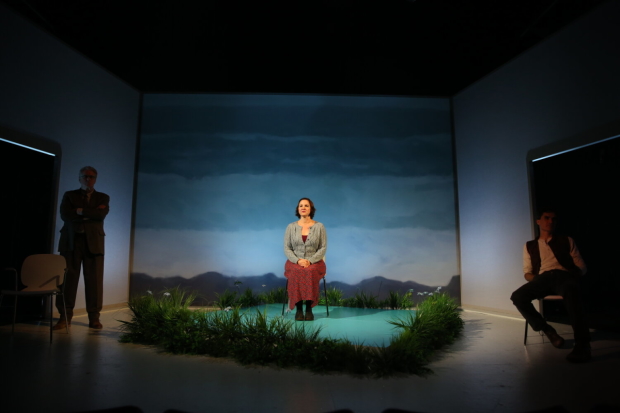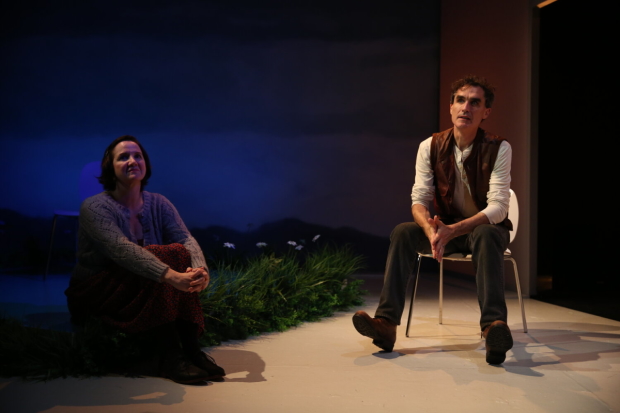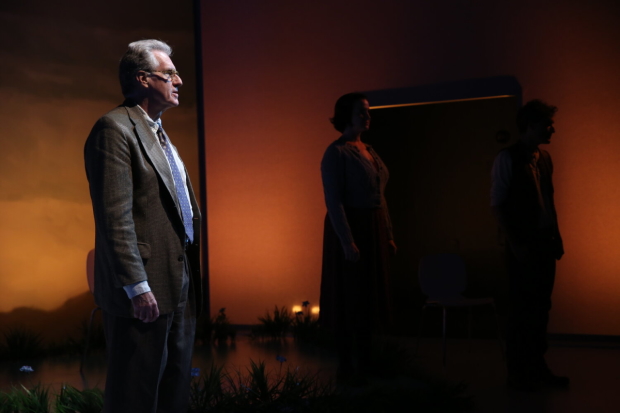Not Much to See, but a Lot to Listen to, in Molly Sweeney
Brian Friel’s play about a woman who regains her sight gets a Keen Company revival.

(© Carol Rosegg)
Most people who attend Molly Sweeney, now running at Theatre Row in a Keen Company revival, will enter the theater believing that the possibility of regaining one's sight after a lifetime of blindness certainly ought to be embraced. Brian Friel's quietly powerful play may have them thinking otherwise. This meditative three-character drama is low on action, but it is filled with evocative prose that paints pictures in the mind. The cast, led by Pamela Sabaugh as Molly, has a tough time keeping things lively for a whole two hours and 20 minutes, but for those who have the stamina, the play offers rewards.
Molly has been blind since she was 10 months old, but her father taught her how to experience the world with her other senses. Later in life, she meets Frank Sweeney (Tommy Schrider), an autodidact who flits from one job or environmental cause to another. He marries Molly after a very brief courtship, and soon she becomes his latest hobby when they decide to have her undergo an operation to restore her sight. It's a great opportunity for Dr. Rice (Paul O'Brien), whose sputtering career could use a shot in the arm. But Molly has apprehensions about learning to see: Will she be as close to her friends? Is she just being used by Dr. Rice? After the successful operation, they must all face what Molly has lost from gaining her sight.

(© Carol Rosegg)
It turns out to be a lot. We learn from Frank, who has done a great deal of scientific and philosophical research into the nature of sensory experience and its relation to knowledge, that once Molly's sight is restored, she will have to create a whole new world of "engrams," correlations between the new experience of seeing people and objects, and the familiar experience of knowing those same things through her other senses. Molly's brain, flooded with the new information provided by her vision, must connect her new sighted experience to the world she knew before. We learn quickly that this is no easy task.
If it weren't for Friel's crisp, lucid prose, listening to actors individually narrate their character's stories to the audience would make for tedious theater, but despite the lack of physical action, the language allows us to "see" a lot. Director Jonathan Silverstein lets the narration do the heavy lifting, and visual distractions are few: Steven Kemp's simple set design has Frank and Dr. Rice in chairs on either side of Molly, elevated on a modest glade of green, suggesting the garden in which her father taught her about flowers when she was a child. All three actors, dressed in intentionally drab costumes by Jennifer Paar, directly address the audience one by one, illuminated by Anshuman Bhatia's soft spotlights as the others sink into the shadows. Under the production's hypnotic lull, it's easy to think of Molly Sweeney as a play for voices.
Yet Sabaugh's Molly does convey a sense of wilting defeat in her face as she shows a desire to retreat into the sightless world that she once knew and retrieve the rich, fulfilling experiences that her other senses rewarded her with all along. It's hard to leave Molly Sweeney without wondering how much would be gained by seeing the play again with eyes closed.

(© Carol Rosegg)








